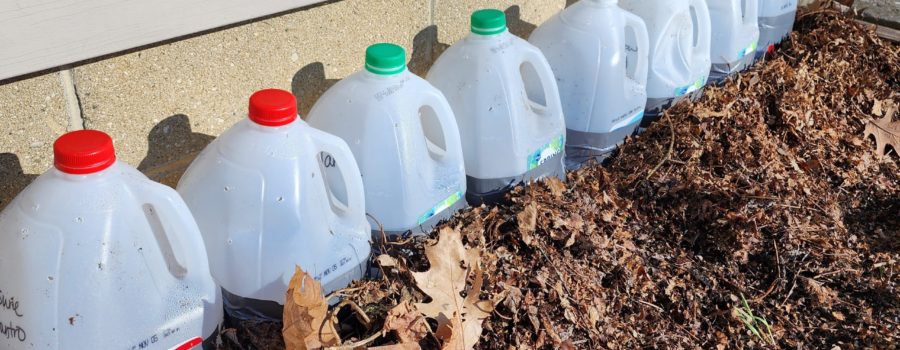
Starting seeds doesn’t have to be some overwhelming thing. You don’t have to have grow lights, racks, seed trays, special soil, and time to water every day.
Supplies you need:
- Water/milk jugs
- Box cutter or something sharp to cut the jug in half.
- Drill to quickly make holes (not necessary, you could use your knife)
- Potting soil
- Water
- Tape
- Marker for labeling (and I like to document the date)
The best time to start this process is late December-February for most US locations. After the winter solstice and before you get into the 50 degrees of spring.
The germination time varies depending on the seedling and the cold weather helps with the stratification of many seeds and triggers the germination as temps start to warm.
Now to answer the question of “what seeds can you winter sow?”
- All perennials
- Classic cool season crops:
- Lettuce, spinach, onions, cabbage, broccoli, cauliflower, and kale.
- Hardy herbs:
- sage, oregano, dill, mint, rosemary (yet difficult), chives, and thyme.
- Hardy annuals:
- Alyssum, dianthus, violas, marigolds, sweet peas, artichoke, and black-eyed Susan.
Once you have planted your seedlings I immediately place my jugs in a sunny location on the South Side of the house. Essentially setting it and forgetting it! Unless you are like me and keep going out every few weeks and peeking in on them…..

As weather starts to consistently warm up into the 50s keep an eye on the soil. You may need to water a bit, have more venting by keeping the cap off and even removing the entire top portion by untapping it. It will really start to warm up inside these containers and you don’t want to cook them. Usually by then they are ready to go into the garden!
When your seedlings have about 2-3 true leaves they will be ready to transplant into your garden beds. No need to harden them off! The perk to winter sowing is they are already ready to go! You get strong, non leggy seeding, that are very tolerant to weather and have a great success rate.
Live.Love.Bloom,
Megan

